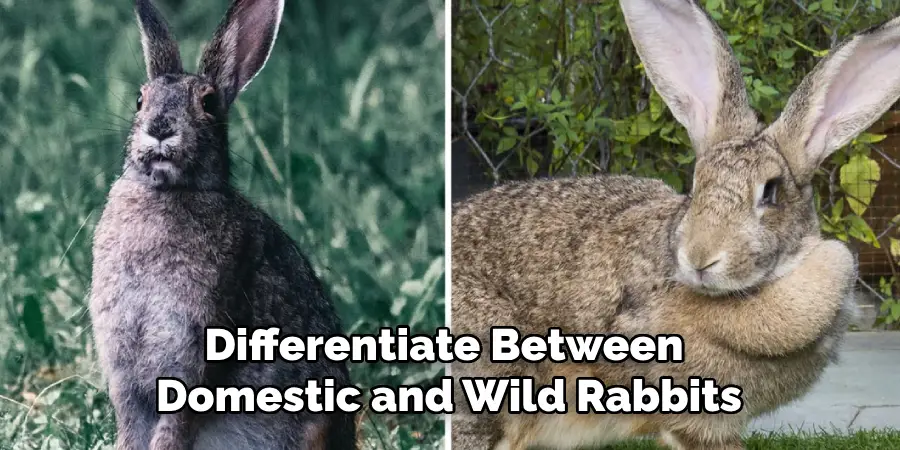Distinguishing between domestic and wild rabbits is crucial for understanding their behavior, needs, and appropriate care. While both share similarities in appearance, certain key characteristics can help differentiate between the two. Domestic rabbits, bred over centuries for companionship, come in a wide range of breeds and colors, often displaying docile behavior around humans.

In contrast, wild rabbits, also known as cottontails, are native to various regions and exhibit a more cautious and skittish demeanor. Understanding these differences is essential for anyone encountering rabbits in the wild or considering adopting one as a pet. In this guide, we’ll delve into the distinct traits and behaviors on how to tell if a rabbit is domestic or wild, equipping readers with the knowledge needed to interact responsibly with these fascinating creatures.
Whether you’re a prospective pet owner or a wildlife enthusiast, recognizing the characteristics of domestic and wild rabbits is key to ensuring their welfare and safety in various environments.
Importance of Distinguishing Between Domestic and Wild Rabbits
The ability to distinguish between domestic and wild rabbits carries significant importance for several reasons. Firstly, it guides appropriate interaction; domestic rabbits are accustomed to human handling and may enjoy social interaction, whereas wild rabbits can become stressed or frightened, potentially leading to injury.
Secondly, understanding the difference is crucial for their welfare. Domestic rabbits depend on humans for care, including specific dietary needs, shelter, and medical attention, which differ markedly from the survival strategies of their wild counterparts. Lastly, it helps in the conservation of wild rabbit populations and their habitats by preventing the unintentional introduction of domestic traits into the wild gene pool, which could have detrimental effects on native ecosystems.
Recognizing these differences ensures that both domestic and wild rabbits are respected and treated according to their distinct needs.
Physical Characteristics
Physical appearance is one of the most straightforward ways to differentiate between domestic and wild rabbits. Domestic rabbits come in a multitude of sizes, shapes, and colors due to selective breeding. They may exhibit various coat types, such as long and silky or short and plush, and their ear sizes can vary significantly, with some breeds having ears that droop down and others that stand erect.

On the other hand, wild rabbits, particularly the common cottontail found in North America, typically have a uniform appearance. They possess a compact body, shorter ears compared to some domestic breeds, and their fur exhibits a blend of brown, grey, and white colors, designed to provide camouflage in their natural habitat. Additionally, wild rabbits’ eyes are adept at detecting movement from predators, often having a more alert and cautious look.
By observing these characteristics, individuals can often make an educated guess about whether a rabbit is domestic or wild, though behaviors and other factors should also be considered to make a precise determination.
Breeds Commonly Kept as Pets or for Agricultural Purposes
When considering rabbit breeds commonly kept either as pets or for agricultural purposes, it’s essential to recognize the variety and versatility of domestic rabbits. For pet owners, breeds such as the Mini Lop, Netherland Dwarf, and the Lionhead are popular choices due to their manageable size, distinctive appearances, and typically friendly dispositions.
The Mini Lop is renowned for its droopy ears and affectionate nature, making it an ideal companion. The Netherland Dwarf, one of the smallest rabbit breeds, is favored for its compact size and playful attitude. Lionheads, distinguishable by their unique mane-like fur around their heads, are also beloved for their good-natured personalities.
In agricultural settings or among breeders, larger breeds like the New Zealand White, Flemish Giant, and French Angora are valued not only for their size but also for their fur and meat production capacities.
The New Zealand White is particularly noted for its large size and white coat, serving well in both meat production and as research animals due to their docile nature. Flemish Giants, known for their impressive size and friendly temperament, are often kept as pets but also play a role in meat production. The French Angora, on the other hand, is sought after for its long, soft wool, which can be spun into yarn.

Each of these breeds has distinct care needs, temperaments, and purposes, making it crucial for prospective rabbit owners or breeders to thoroughly research and consider what breed best fits their capacity to provide proper care and environment.
Body Size and Proportions
The body size and proportions of a rabbit are significant indicators that can help distinguish between a domestic and a wild rabbit. Domestic rabbits vary widely in size, ranging from the tiny 2-pound Netherland Dwarf to the massive Flemish Giant, which can weigh over 15 pounds.
This considerable variation in size among domestic breeds is a result of selective breeding for specific traits, including size, by humans. In contrast, wild rabbits, such as the Eastern cottontail, tend to have a more uniform size, generally weighing between 2 to 4 pounds as adults, which is optimized for their survival in the wild.
In terms of proportions, domestic rabbits can have diverse body shapes, from the compact and rounded forms of the Mini Lop to the elongated and muscular build of the Flemish Giant. Their body composition is often aligned with their breed’s intended purpose, such as show, companionship, or meat production. Wild rabbits, meanwhile, exhibit a consistent body shape that is aerodynamic, with strong hindquarters that are adapted for quick evasion of predators.
This body structure enables them to rapidly escape threats in their environment, showcasing the natural selection pressures that have shaped their physical evolution.
Understanding these size and proportion differences is crucial when encountering a rabbit and trying to determine its origin. Domestic rabbits’ varied sizes and body types reflect human preferences and breeding practices, while the more standardized size and shape of wild rabbits reflect the requirements of survival in their natural habitats.
Behavior Patterns
Behavior patterns offer another compelling distinction between domestic and wild rabbits. Domestic rabbits, accustomed to human interaction, often exhibit a broader range of behaviors reflecting their comfort with humans. They might seek out attention, display curiosity towards new objects and environments, and in some cases, can be trained to perform simple tasks or tricks.

Many domestic rabbits enjoy being petted and will approach their owners for affection. On the contrary, wild rabbits are inherently more cautious and skittish, a trait that has evolved as a survival mechanism. They are highly alert to their surroundings, ready to flee at the first sign of danger. This instinctual behavior is evident in their quick, erratic movements and the use of burrows or dense cover as refuge.
Social behaviors also vary significantly. While domestic rabbits can adapt to living alone if given enough attention by their owners, they generally thrive in pairs or small groups where they can interact and form bonds. On the other hand, wild rabbits are often observed in larger groups known as colonies or warrens, where they establish complex social structures and communicate through a variety of vocalizations and physical behaviors not commonly seen in domesticated rabbits.
Furthermore, domestic rabbits have adapted to a more sedentary lifestyle compared to their wild counterparts, who must constantly forage for food, avoid predators, and defend territories. This difference in daily activity levels is a direct consequence of the contrasting environments in which they live. Overall, understanding and recognizing these behavior patterns is essential for providing appropriate care to domestic rabbits and appreciating the instincts of wild rabbits in their natural habitat.
Common Species of Wild Rabbits
Among the myriad of rabbit species found in the wild, several stand out due to their widespread distribution and the roles they play in their respective ecosystems. The Eastern Cottontail (Sylvilagus floridanus) is perhaps the most recognized species in North America, easily identified by its distinctive fluffy white tail.
It inhabits meadows, gardens, and woods, where it feeds on a variety of vegetation. The European Rabbit (Oryctolagus cuniculus), native to southwestern Europe and northwest Africa, has been introduced to many other parts of the world. It is the ancestor of all domesticated rabbit breeds and is known for its complex social structure and burrowing behavior. Another notable species is the Mountain Cottontail (Sylvilagus nuttallii), found in the western United States and known for its preference for rocky territories and higher elevations.
The Desert Cottontail (Sylvilagus audubonii), as its name suggests, is adapted to the arid conditions of the American Southwest and Mexico. It employs unique behaviors to cope with the extreme temperatures of its environment, like being most active during the cooler hours of dawn and dusk. Lastly, the Snowshoe Hare (Lepus americanus), which is not a rabbit but often grouped with them due to similar appearance and behavior, is remarkable for its seasonal coat color changes from brown in summer to white in winter, an adaptation that provides camouflage against predators in varying landscapes.

These species, among others, play crucial roles in their habitats as both prey and consumer, contributing to the biodiversity and ecological balance of their environments. Understanding and protecting these wild rabbits is vital for maintaining the health and sustainability of our natural world.
Habitat and Environment
The environments inhabited by rabbits, both domestic and wild, vary significantly and play a crucial role in their behavior, diet, and overall survival. Domestic rabbits are often found in controlled environments such as homes or specially designed outdoor enclosures.
These settings provide them with shelter from extreme weather conditions and predators, alongside a consistent food supply. However, it’s essential to mimic their natural habitat to some extent to ensure their well-being, including providing spaces for them to burrow, hide, and exercise.
In contrast, wild rabbits are highly adaptable to a wide range of habitats. The Eastern Cottontail, for example, thrives in the mixed landscapes of fields and wooded areas where cover and food sources are plentiful.
European Rabbits prefer open landscapes such as grasslands, agricultural fields, and woodland edges, where their complex burrow systems can be constructed. The Desert Cottontail has evolved to survive in the harsh conditions of the desert, seeking shade and moisture in the early morning and late evening hours.
Mountain Cottontails and Snowshoe Hares, meanwhile, occupy higher elevation and snowy regions, respectively, showcasing remarkable adaptability to extreme conditions.

Wild rabbits’ habitats are not only crucial for their survival but also for the ecosystems they inhabit. They contribute to the health of the soil through their burrowing activity, aid in seed dispersion, and act as a vital food source for a variety of predators. Conserving these habitats is essential for maintaining balanced ecosystems and ensuring the survival of these species.
7 Methods How to Tell if a Rabbit Is Domestic or Wild
1. Physical Characteristics:
a. Fur Color and Texture: Domestic rabbits often exhibit a wider range of fur colors and textures, including solid colors, patches, and spots, whereas wild rabbits typically have fur that blends with their natural surroundings, such as brown or gray fur.
b. Body Size and Proportions: Domestic rabbits tend to be larger and bulkier than wild rabbits, which are usually more slender and streamlined in build.
c. Ear Shape and Size: Domestic rabbit breeds may have various ear shapes, including lop ears, upright ears, or ears with distinct markings, while wild rabbits typically have large, upright ears that help them detect predators.
2. Behavioral Cues:
a. Reaction to Humans: Domestic rabbits are often more tolerant of human interaction and may approach humans willingly, while wild rabbits are typically wary and skittish around humans, preferring to avoid direct contact.
b. Nesting and Burrowing Behavior: Domestic rabbits may create nests or burrows in captivity, but their behavior may differ from that of wild rabbits, which are skilled diggers and often create complex burrow systems for shelter.
c. Movement Patterns and Speed: Domestic rabbits may exhibit different movement patterns, such as hopping or running, but they generally lack the agility and speed of wild rabbits, which are adapted for swift escapes from predators.
3. Habitat and Environment:
a. Preferred Habitats of Wild Rabbits: Wild rabbits typically inhabit grasslands, woodlands, or areas with dense vegetation where they can find adequate cover and food sources.
b. Signs of Wild Rabbit Activity: Look for signs such as burrows, feces, tracks, or chewed vegetation to indicate the presence of wild rabbits in an area.
c. Indications of Domestic Rabbit Ownership: If the rabbit is found in a residential area or near human habitation, it’s more likely to be a domestic rabbit that has escaped or been released.

4. Interaction with Other Animals:
a. Relationship with Other Rabbits: Domestic rabbits may be kept singly or in pairs/groups as pets, while wild rabbits typically live in social groups known as warrens.
b. Response to Predators: Domestic rabbits may exhibit less fear or awareness of potential predators compared to wild rabbits, which are more vigilant and quick to flee at the slightest sign of danger.
c. Socialization with Humans and Pets: Domestic rabbits are often socialized from a young age and may be comfortable interacting with humans and other household pets, whereas wild rabbits are more likely to avoid human contact and interactions with unfamiliar animals.
5. Vocalizations and Communication:
a. Vocalizations of Domestic Rabbits: Domestic rabbits may vocalize in response to human interaction, food, or perceived threats, whereas wild rabbits tend to be quieter to avoid drawing attention to themselves.
b. Sounds Made by Wild Rabbits: Wild rabbits may produce alarm calls, thumping noises, or soft grunts as part of their communication with other rabbits or to alert members of their warren to potential danger.
c. Understanding Rabbit Body Language: Both domestic and wild rabbits use body language, such as ear positioning, tail movement, and body posture, to communicate with each other and with humans.
6. Identifying External Markings:
a. Ear Tags or Tattoos (for Domestic Rabbits): Some domestic rabbits may have ear tags or tattoos indicating ownership or breeding information.
b. Natural Scars or Injuries: Wild rabbits may have scars or injuries from encounters with predators or territorial disputes.
c. Distinctive Coat Patterns or Markings: Look for unique coat patterns or markings that may indicate a specific domestic rabbit breed or individual variation.

7. Utilizing Resources and Tools:
a. Field Guides and Online Resources: Consult field guides or online resources with images and descriptions of domestic and wild rabbit characteristics for comparison.
b. Local Wildlife Organizations or Experts: Reach out to local wildlife organizations or experts for assistance in identifying wild rabbits or determining the appropriate course of action if you encounter one.
c. Veterinary Assistance for Confirmation: If unsure about a rabbit’s origin or health status, seek veterinary assistance for a professional evaluation and confirmation.
Conclusion
In conclusion, being able to distinguish between domestic and wild rabbits is essential for their proper care and management. By understanding the behavioral cues, physical characteristics, and habitat preferences of each type, individuals can make informed decisions about interacting with rabbits, whether in the wild or as pets. Recognizing the differences between domestic and wild rabbits also fosters a deeper appreciation for these remarkable animals and their unique roles in both natural and human-influenced environments.
Whether observing them in the wild or caring for them as pets, responsible stewardship requires us to respect their inherent traits and provide appropriate care tailored to their needs. Be sure to follow all instructions on how to tell if a rabbit is domestic or wild carefully, and always consult an expert when in doubt.
About
Outdoor Fixes is a distinguished figure in the world of Diy design, with a decade of expertise creating innovative and sustainable Diy solutions.
His professional focus lies in merging traditional craftsmanship with modern manufacturing techniques,
fostering designs that are both practical and environmentally conscious. As the author of diy,
outdoorfixes delves into the art and science of outdoorfixes-making, inspiring artisans and industry professionals alike.
Education RMIT University
(Melbourne, Australia) Associate Degree in Design (Outdoor Fixes) Focus on sustainable design, industry-driven projects,
and practical craftsmanship. Gained hands-on experience with traditional and digital manufacturing tools, such as CAD and CNC software.
Nottingham Trent University
(United Kingdom) Bachelor’s in outdoorfixes.com and Product Design (Honors) Specialized in product design with a focus on blending creativity with production
techniques. Participated in industry projects, working with companies like John Lewis and Vitsoe to gain real-world insights.
Publications and Impact
In diy, Outdoor Fixes his insights on indoor design processes, materials, and strategies for efficient production.
His writing bridges the gap between artisan knowledge and modern industry needs, making it a must-read for both budding designers and seasoned professionals.

